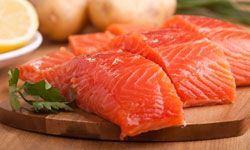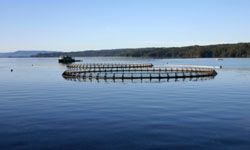“
 “Is wild Pacific salmon worth the extra cost?iStockphoto.com/Olgna
“Is wild Pacific salmon worth the extra cost?iStockphoto.com/Olgna
In the last 20 years, salmon farming has tripled the world supply of salmon. In 1985, only 6 percent of salmon you’d find at the grocery was farmed. But in 2000, 58 percent came from farm production, according to a University of Albany study.
Farmed Atlantic salmon accounts for 85 percent of all of the world’s farmed salmon. Due to the surge in the availability of farm-raised salmon, it’s less expensive than wild salmon. In fact, while farmed Atlantic salmon costs $6 to $7 a pound, wild Pacific salmon can cost two or three times that much.
So when should you save and buy the farmed salmon, and when should you splurge on the wild stuff?
Contents
- Health Benefits of Salmon
- Salmon and the Environment
- Which is Healthier — Farmed or Wild Salmon?
- To Save or Splurge on Salmon
Health Benefits of Salmon
Not only is salmon tasty to eat, but it’s highly nutritious and beneficial to your health. It’s low in calories, high in protein and a great source of the essential fatty acids, omega-3. While all fish contain these "good fats," they’re especially plentiful in salmon.
Omega-3 fatty acids benefit vision and brain development in infants and cardiovascular and immune health in adults. In addition, salmon contains selenium, a source of protein, magnesium and vitamin B6. Both wild and farmed salmon have relatively low levels of mercury and other metals.
Salmon’s nutritional value makes it a healthy dish. But which kind of salmon should you buy? As far as taste goes, the jury is still out. While many people claim they prefer the taste of fresh wild salmon, other people can’t tell the difference. Basically, the wild vs. farmed salmon debate boils down to three main points: environmental issues, contamination and omega 3-fatty acid levels. More about the environment on the next page.
Salmon and the Environment
 “
“ “If farmed salmon are diseased or ridden with sea lice, those problems can easily pass to wild salmon populations.iStockphoto/Thinkstock
“If farmed salmon are diseased or ridden with sea lice, those problems can easily pass to wild salmon populations.iStockphoto/Thinkstock
The reason almost all Atlantic salmon comes from farms is that overfishing, pollution and the damming of rivers in North America and Europe have destroyed the salmon fisheries in the Atlantic. In fact, wild Atlantic salmon is currently on the endangered species list.
Compared to Pacific salmon, Atlantic salmon grow faster and respond better to crowded farming pens. Farmed Atlantic salmon is available anywhere year round for usually under $8 a pound. On the other hand, fresh wild Pacific salmon is only available between May and October. During the winter months, you’ll have to purchase frozen Pacific salmon.
Even though farmed salmon is cheaper and more readily available than wild salmon, its production may pose threats to fish and the environment. There’s always a threat that farmed Atlantic salmon will spread diseases to the wild salmon stocks that share the same waterways. Salmon farming pens can also become polluted due to overcrowding or decreased water circulation. This pollution can enter other bodies of water and contaminate wild populations of fish. Atlantic salmon can also spread sea lice beyond their pens.
However, despite these risks, the farming of salmon can benefit local communities. Salmon farms are typically found in rural areas, and their establishment of these farms helps boost struggling economies.
But which type of salmon is better for your health? Read about that on the next page.
Which is Healthier — Farmed or Wild Salmon?
Wild salmon may be a healthier choice than farmed salmon. Studies have shown that farmed salmon may contain up to 10 times the concentration of contaminants and polychlorinated biphenyls (PCBS) than wild salmon stocks, because of what farmed salmon are fed. However, other studies have found that farmed and wild salmon contain similar levels of contaminants.
The farmed fish that’s available in the United States generally comes from Maine, Washington, Canada and Chile, and, according to the Washington State Department of Health, these sources of salmon have lower contaminant levels than fish farmed in Europe. Farmed salmon is also treated with antibiotics and fed a dye that turns the flesh of the fish pink, instead of its usual gray color.
Farmed salmon is fattier than wild salmon. But it’s actually lower in good-for-you omega-3 fatty acids because the feed it’s given contains plant oils. Because of contaminant risks, it’s recommended that farmed salmon be cooked to reduce the fat content and that the skin and fatty tissue be removed before eating.
Or, you can simply splurge for the wild salmon. It has 20 percent higher protein content and 20 percent lower fat content than farmed salmon. More on that on the next page.
To Save or Splurge on Salmon
 “
“ “Read the label on the package to be sure the "wild salmon" really came from the wild.Hemera/Thinkstock
“Read the label on the package to be sure the "wild salmon" really came from the wild.Hemera/Thinkstock
So, do the health benefits and environmental concerns outweigh the cash you’ll save if you buy Atlantic salmon? Well, that depends.
Be sure to research carefully where your salmon is coming from, even if you’re buying wild salmon. Unfortunately, what’s sometimes marketed as Pacific salmon is actually Atlantic. According to one study, six of eight fish shops were selling farmed salmon that was marketed as wild. When buying wild salmon, particularly during the off-season, ask to see a label or ask where the wild fish came from.
Basically, any kind of salmon is going to be good for you. It’s good for your health, particularly your heart and your brain, and it’s an excellent source of the all-important omega-3 fatty acids. While wild salmon is the best choice for the environment and for your body, farmed salmon can be a good alternative if you’re watching your wallet.
Lots More Information
Related Articles
- 5 Foods That Will Make You Happier
- How to Choose Carbohydrates
- Health Benefits of Vinegar
- 10 Most Common Food Product Substitutes
- 10 Reasons You Should Have Lemons in Your Fridge
Sources
- "Benefits of Aquaculture." Salmon of the Americas. http://www.salmonoftheamericas.com/oceanfarming/aquaculture.html
- "General Information about World Salmon Production and Consumption." University of Albany. http://www.albany.edu/ihe/salmonstudy/background.html
- "Is there any nutritional difference between wild-caught and farm-raised fish?Is one type better for me than the other?" The World’s Healthiest Foods. http://www.whfoods.com/genpage.php?tname=george&dbid=96
- "PCBs: Is farmed salmon safe to eat?" Health Castle http://www.healthcastle.com/farmed-salmon.shtml
- "Salmon." The World’s Healthiest Foods. http://www.whfoods.com/genpage.php?tname=foodspice&dbid=104
- "Wild vs. Farmed Salmon." Fish Facts for Healthy Nutrition. Washington State Department of Health. http://www.doh.wa.gov/ehp/oehas/fish/farmedsalmon.htm


